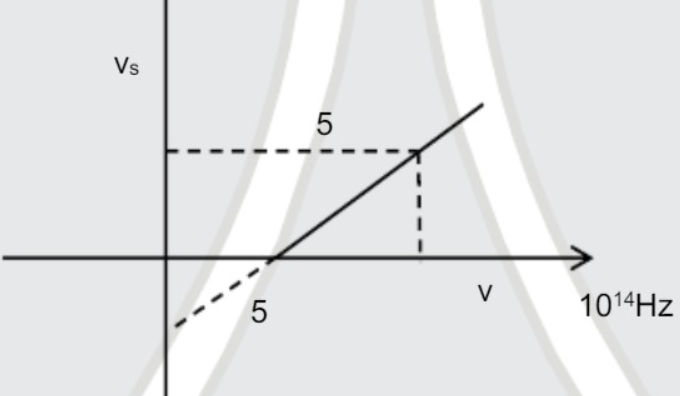The work function of Silver and sodium are 4.6and2.3eV, respectively . The ratio of the slope of the stopping potential versus frequency plot for silver to that of sodium is
The correct Answer is:1
To solve the problem, we need to find the ratio of the slopes of the stopping potential versus frequency plot for silver and sodium. The work functions for silver and sodium are given as 4.6 eV and 2.3 eV, respectively.
1. Understand the Photoelectric Equation:
The photoelectric effect can be described by the equation:
Ek=hν−ϕ
where Ek is the kinetic energy of the emitted electrons, h is Planck's constant, ν is the frequency of the incident light, and ϕ is the work function of the material.
2. Relate Kinetic Energy to Stopping Potential:
The stopping potential V0 is related to the kinetic energy by:
Ek=eV0
where e is the charge of the electron. Thus, we can rewrite the photoelectric equation as:
eV0=hν−ϕ
3. Rearranging the Equation:
Rearranging gives us:
V0=heν−ϕe
This equation is in the form of y=mx+c, where:
- y is V0
- x is ν
- m (the slope) is he
- c (the y-intercept) is −ϕe
4. Finding the Slope:
From the equation, the slope m is constant and equal to he. This means that the slope does not depend on the material but rather on fundamental constants.
5. Calculating the Ratio of Slopes:
Since the slope for both silver and sodium is he, we can write:
Slope for Silver=he
Slope for Sodium=he
Therefore, the ratio of the slopes is:
Ratio=Slope for SilverSlope for Sodium=hehe=1
Final Answer:
The ratio of the slope of the stopping potential versus frequency plot for silver to that of sodium is 1.
The photoelectric effect can be described by the equation:
Ek=hν−ϕ
where Ek is the kinetic energy of the emitted electrons, h is Planck's constant, ν is the frequency of the incident light, and ϕ is the work function of the material.
The stopping potential V0 is related to the kinetic energy by:
Ek=eV0
where e is the charge of the electron. Thus, we can rewrite the photoelectric equation as:
eV0=hν−ϕ
Rearranging gives us:
V0=heν−ϕe
This equation is in the form of y=mx+c, where:
- y is V0
- x is ν
- m (the slope) is he
- c (the y-intercept) is −ϕe
From the equation, the slope m is constant and equal to he. This means that the slope does not depend on the material but rather on fundamental constants.
Since the slope for both silver and sodium is he, we can write:
Slope for Silver=he
Slope for Sodium=he
Therefore, the ratio of the slopes is:
Ratio=Slope for SilverSlope for Sodium=hehe=1
The ratio of the slope of the stopping potential versus frequency plot for silver to that of sodium is 1.
Topper's Solved these Questions
- ATOMIC PHYSICSBOOK - RESONANCE ENGLISHCHAPTER - ATOMIC PHYSICSEXERCISE - Advanved level problems
17 Videos
- ATOMIC PHYSICSBOOK - RESONANCE ENGLISHCHAPTER - ATOMIC PHYSICSEXERCISE - Exercise-2 Part-III : Comprehension
12 Videos
- ALTERNATING CURRENTBOOK - RESONANCE ENGLISHCHAPTER - ALTERNATING CURRENTEXERCISE - HIGH LEVEL PROBLEMS
11 Videos
- CAPACITANCEBOOK - RESONANCE ENGLISHCHAPTER - CAPACITANCEEXERCISE - High Level Problems
16 Videos
Similar Questions
Knowledge Check
In photoelectric effect experiment, the slope of the graph of the stopping potential versus frequency gives the value of :
AheBhCehDhceThe work function for Al, K and Pt is 4.28 eV, 2.30 eV and 5.65 eV respectively. Their respective threshold frequencies would be
APt>Al>KBAl>Pt>KCK>Al>PtDAl>K>Pt
Sodium and copper have work functions 2.3eVand4.5eV respectively . Then the ratio of the wavelength is nearest
View SolutionThe work function for tungsten and sodium are 4.5eV and 2.3eV respectively . If the threshold wavelength λ for sodium is 5460Å, the value of λ for tungsten is
View SolutionThe work functions of tungsten and sodium are 5.06eV and 2.53eV respectively. If the threshold wavelenth for sodium is 5896Å, then the threshold wavelength for the tungsten will be
View Solution(i) Plot a labelled graph of |Vs| where Vs is stopping potential versus frequency f of the incident radiation.
(ii) State how will you use this graph to determine the value of Planck.s constant.
View SolutionIf the work functions of three photosensitive materials are 1 eV, 2 eV and 3 eV respectively, then the ratio of the respective frequencies of light that produce photoelectrons of the maximum kinetic energy of 1 eV from each of them is
View SolutionGraph between stopping potential and frequency of light as shown find the work function

View Solution
